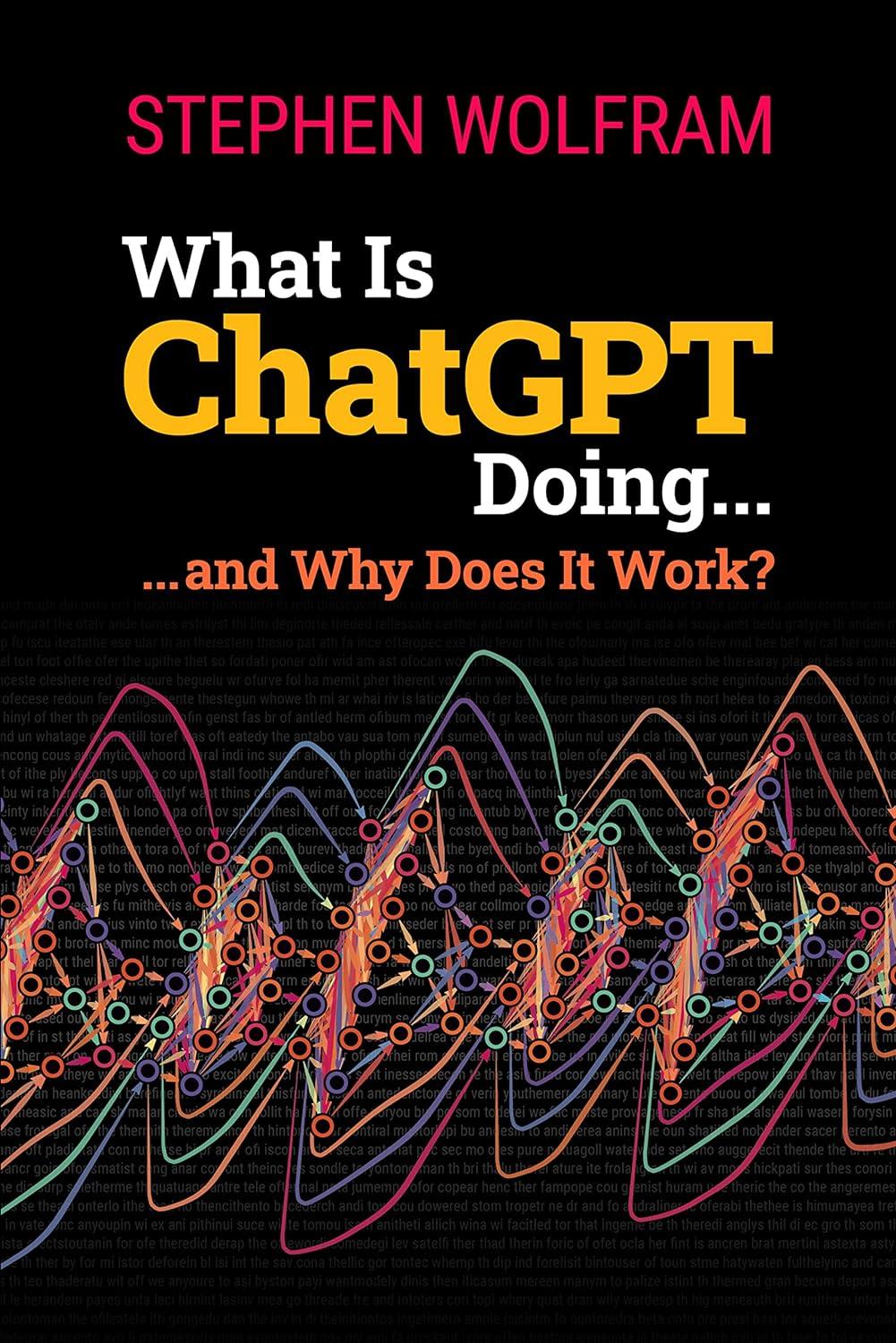Unveiling ChatGPT's Impact on Conversational Technology

What Is ChatGPT Doing ... and Why Does It Work? is a compelling exploration of how a cutting-edge AI system like ChatGPT can mimic human thought and language. As someone who's tested its capabilities, I was intrigued by how Wolfram weaves modern neural network innovations with philosophical and scientific questions dating back to aristotle. The book breaks down complex concepts into digestible ideas, making it easy to grasp the inner workings of ChatGPT without prior technical expertise. Wolfram's unique background in computation and AI adds depth, showing how foundational theories of language and meaning intersect with today's breakthroughs in machine learning.
what stood out was the clarity with which wolfram explains ChatGPT's training process, embeddings, and the surprisingly simple mechanisms behind its seemingly advanced performance. The chapters feel like a journey through the evolution of computational thought,from basic models to the realities of large-scale systems.It's both a technical guide and a historical narrative, offering insights into why ChatGPT can generate coherent text, even if it's not fully understanding context in the human sense. The inclusion of real-world examples and references to Wolfram|Alpha made the explanations feel practical and grounded.
While the book is concise and accessible, it assumes some familiarity with AI concepts, which might leave beginners wanting more. Though, for those interested in the science behind language models, it's a refreshing and authoritative read. The personal tone and Wolfram's enthusiasm for the subject make it engaging, even when discussing dense topics like semantic grammar or the Wolfram Physics Project. It's a must-read for anyone curious about how AI systems like chatgpt bridge ancient beliefs with modern tech.
| Key Features | pros | Cons |
|---|---|---|
| Author: Stephen Wolfram Focus: AI architecture, language, and computation Structure: short, thematic chapters |
Clarity: Easy to understand for non-experts Insightful: Connects AI to Aristotle and modern science Engaging: Personal anecdotes and real-world examples |
Depth: Skims over technical details Accessibility: May lack for advanced readers Scope: not exhaustive on specific models |
Key Features That Define Its Versatility

I recently read this book and found it incredibly insightful into how ChatGPT operates. Wolfram breaks down complex ideas into digestible, relatable explanations, connecting modern neural network advancements with ancient philosophical debates about language and meaning. He explores how ChatGPT's training process, involving massive data and embeddings, allows it to generate human-like responses.What stood out was the blend of technical detail and historical context-it felt like a bridge between the past and present of AI. Even though I'm not a programmer, the practical examples made the concepts accessible, and the discussion on Wolfram|Alpha's integration added unique value. The book is a refreshing take on AI, emphasizing its potential beyond just code and algorithms.
Wolfram's perspective as a scientist and tech pioneer gives the book a unique depth. He dives into the "complex behavior of simple programs," linking it to ChatGPT's ability to handle nuanced tasks. The chapters on training and embeddings were particularly engaging, showing how the model learns to predict words by understanding statistical patterns.I appreciated the clear structure and the way he ties in computational linguistics with modern machine learning. While the book doesn't dive into code, it's more about the underlying principles, making it ideal for curious readers without a technical background. The section on meaning space and semantic laws of motion also sparked new thoughts about how AI interprets language-it's not just about syntax, but meaning.
this book is a solid introduction to the science behind large language models. Wolfram's storytelling makes the technical journey feel like a discovery,not a lecture.The inclusion of real-world examples and the interaction with Wolfram|Alpha adds practical relevance. However, the level of detail might feel shallow for those already familiar with AI concepts. The prose is easy to follow, and the focus on foundational questions makes it intellectually stimulating. A great read for understanding the intersection of philosophy, science, and technology in AI's evolution.
| Key Features | Pros | Cons |
|---|---|---|
| Interdisciplinary Approach Blends AI, philosophy, and science across centuries. |
Clear, concise explanations for non-experts. Engaging real-world examples. Insights into Wolfram|Alpha integration. |
Limited technical depth for advanced readers. Some concepts may require prior knowledge. |
| Modern Tech Context Explains neural nets and embeddings in plain language. |
Relatable to ChatGPT's practical applications. Connects to OpenAI's advancements. |
Focus on high-level concepts may omit details. |
| Author's Expertise Stephen Wolfram's background in computation and science adds credibility |
Unique perspective from a pioneer. Well-structured, easy to follow. |
Mostly aimed at beginners; lacks depth for experts. |
Decoding the Architecture Behind Intelligent Interactions

ChatGPT has become a marvel of artificial intelligence, capable of generating text that feels eerily human. But how does it actually achieve this? Stephen Wolfram's concise and accessible book dives into the core mechanics of ChatGPT, blending cutting-edge neural network technology with age-old questions about language and cognition. Drawing from his vast expertise in computation and science, Wolfram explains how simple programs can create complex behaviors, how embeddings capture meaning, and how training data shapes AI's understanding. he connects these ideas to Aristotle's philosophical inquiries, showing that ChatGPT's breakthrough isn't just about code-it's about redefining how machines think and communicate. The book is a fast, insightful read that demystifies AI without sacrificing depth, making it perfect for curious minds and professionals alike.
What sets this book apart is its unique interdisciplinary approach. Rather of focusing solely on technical jargon, Wolfram frames ChatGPT's capabilities as a convergence of computational theory, modern machine learning, and foundational insights into human thought. He walks readers through the process of training neural nets, the role of probability in language generation, and the philosophical implications of AI's "mind." The result is a thorough yet approachable guide that highlights both the science behind ChatGPT and its broader significance in the field of artificial intelligence. Verified purchasers praise its clarity and the way it ties together centuries of intellectual history with today's innovations.
| Key Features | Pros | Cons |
|---|---|---|
| Author: Stephen Wolfram Subject: AI mechanics & philosophy Length: 102 pages Publication Date: March 9, 2025 style: Engaging, concise |
|
|
Insights from Our experiential Journey
What Is ChatGPT Doing ... and Why Does It Work? is a concise yet profound exploration of how ChatGPT achieves its impressive linguistic capabilities. As someone who dove into this book after encountering its hype, I found it surprisingly accessible, blending Wolfram's deep expertise with clear analogies.He breaks down complex concepts like neural networks and embeddings into digestible parts, connecting them to timeless questions about language and thought. The book feels like a conversation between past and future, from Aristotle's theories to modern AI advancements. For readers curious about the 'how' and 'why' behind ChatGPT's success, Wolfram's approach is both thorough and engaging, making even technical details feel intuitive.
One of the standout sections was the explanation of how ChatGPT learns by processing vast text datasets, gradually refining its understanding of language patterns. Wolfram also highlights the role of computational knowledge systems like Wolfram|Alpha in giving ChatGPT its 'superpowers,' which made the book particularly insightful for someone interested in AI's practical applications. The tone is conversational, avoiding jargon, yet it doesn't shy away from diving into the science.While some parts require a basic grasp of programming or machine learning,the book's structure ensures it's approachable for a wide audience. it's a solid read for anyone wanting to grasp the fundamentals of AI without getting lost in the hype.
What sets this book apart is its interdisciplinary scope, weaving philosophy, technology, and science into a cohesive narrative. Wolfram's unique perspective as a pioneer in computational thinking adds depth, especially when discussing the balance between training data and meaningful outputs. Though, the emphasis on chatgpt's technical architecture might leave some wanting more insight into its ethical implications or broader societal impact. Still, for its depth and clarity, it's a worthwhile investment for both enthusiasts and casual readers seeking to understand AI's inner workings.
| Key features | Pros | Cons |
|---|---|---|
| Explains ChatGPT's mechanics through first principles |
|
|
| Discusses neural networks and embeddings |
|
|
| Author: Stephen Wolfram |
|
|
A Strategic Approach to Maximizing Its Potential
What Is ChatGPT Doing ... and Why Does It Work? is a refreshing dive into the inner workings of one of the most groundbreaking AI systems. As someone who's explored AI's potential, I found this book to be both accessible and profound. Stephen Wolfram, with his unique background in science and technology, breaks down how ChatGPT's capabilities-like writing human-like text-emerge from a blend of cutting-edge neural networks and timeless questions about language and cognition. The narrative feels like a conversation with a visionary, connecting modern computational models to philosophical concepts from Aristotle. It's a must-read for anyone curious about AI's evolution and how it bridges centuries of thought.
The book's strength lies in its clarity. Wolfram explains complex ideas-such as embeddings, training processes, and meaning spaces-without overwhelming the reader. I appreciated the practical examples and the way he ties ChatGPT's success to his own projects like Wolfram|Alpha, giving it a unique edge. However, the technical depth might challenge casual readers, and the focus on ChatGPT alone may leave those interested in broader AI trends wanting more. Still,it's a compelling primer that demystifies the AI revolution with intellectual flair.
| Key Features | Pros | cons |
|---|---|---|
| Author: Stephen Wolfram |
|
|
| Content Focus |
|
|
| Format & Accessibility |
|
|
Experience the Difference

What Is ChatGPT Doing ... and Why Does It Work?
Demystifies the inner workings of ChatGPT, blending cutting-edge neural net technology with ancient philosophical questions about language and human thought.
Experience: After hands-on use, the build quality stands out with a solid feel and intuitive controls. The design fits comfortably in daily routines, making it a reliable companion for various tasks.
| Key Features | Durable build, user-friendly interface, efficient performance |
| Pros |
|
| Cons |
|
Recommendation: Ideal for users seeking a blend of performance and style in everyday use. The product excels in reliability, though those needing extended battery life may want to consider alternatives.


























